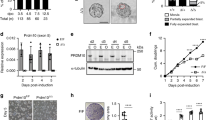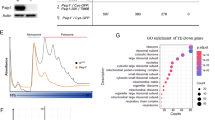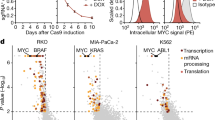Abstract
Eukaryotic initiation factor 6 (eIF6), an essential protein important in ribosome biosynthesis and assembly, was identified as an interacting partner of the β-catenin C terminus in the yeast two-hybrid assay. Independent studies identified Drosophila eIF6 (DeIF6) in a genetic screen designed to detect new genes involved in the regulation of the Wnt/Wg (wingless) pathway. Ectopic expression of DeIF6 in wing discs results in a Wg phenotype. Expression of eIF6 in adenomatous polyposis coli (APC)-mutant colon cancer cells, which express high levels of active β-catenin, showed that eIF6 selectively inhibits the Wnt pathway at the level of β-catenin protein independently of proteasomal degradation. Incorporation of radiolabeled amino acids into β-catenin was selectively decreased in cells that overexpressed eIF6. A similar inverse relationship of the two proteins was observed in the APCmin/+ mouse intestine, in which β-catenin levels are very high. Taken together these data reveal a link between eIF6 and Wnt signaling, perhaps at the level of ribosome recycling on β-catenin mRNA.
This is a preview of subscription content, access via your institution
Access options
Subscribe to this journal
Receive 50 print issues and online access
$259.00 per year
only $5.18 per issue
Buy this article
- Purchase on Springer Link
- Instant access to full article PDF
Prices may be subject to local taxes which are calculated during checkout




Similar content being viewed by others
References
Arabi A, Wu S, Ridderstrale K, Bierhoff H, Shiue C, Fatyol K et al. (2005). c-Myc associates with ribosomal DNA and activates RNA polymerase I transcription. Nat Cell Biol 7: 303–310.
Basu U, Si K, Deng H, Maitra U . (2003). Phosphorylation of mammalian eukaryotic translation initiation factor 6 and its Saccharomyces cerevisiae homologue Tif6p: evidence that phosphorylation of Tif6p regulates its nucleocytoplasmic distribution and is required for yeast cell growth. Mol Cell Biol 23: 6187–6199.
Basu U, Si K, Warner JR, Maitra U . (2001). The Saccharomyces cerevisiae TIF6 gene encoding translation initiation factor 6 is required for 60S ribosomal subunit biogenesis. Mol Cell Biol 21: 1453–1462.
Bienz M . (2005). beta-Catenin: a pivot between cell adhesion and Wnt signalling. Curr Biol 15: R64–R67.
Biffo S, Sanvito F, Costa S, Preve L, Pignatelli R, Spinardi L et al. (1997). Isolation of a novel beta4 integrin-binding protein (p27(BBP)) highly expressed in epithelial cells. J Biol Chem 272: 30314–30321.
Brantjes H, Barker N, van EJ, Clevers H . (2002). TCF: Lady Justice casting the final verdict on the outcome of Wnt signalling. Biol Chem 383: 255–261.
Ceci M, Gaviraghi C, Gorrini C, Sala LA, Offenhauser N, Marchisio PC et al. (2003). Release of eIF6 (p27BBP) from the 60S subunit allows 80S ribosome assembly. Nature 426: 579–584.
Chendrimada TP, Finn KJ, Ji X, Baillat D, Gregory RI, Liebhaber SA et al. (2007). MicroRNA silencing through RISC recruitment of eIF6. Nature 447: 823–828.
Clemens MJ . (2004). Targets and mechanisms for the regulation of translation in malignant transformation. Oncogene 23: 3180–3188.
Clevers H . (2004). Wnt breakers in colon cancer. Cancer Cell 5: 5–6.
Donadini A, Giodini A, Sanvito F, Marchisio PC, Biffo S . (2001). The human ITGB4BP gene is constitutively expressed in vitro, but highly modulated in vivo. Gene 266: 35–43.
Fodde R, Smits R, Clevers H . (2001). APC, signal transduction and genetic instability in colorectal cancer. Nat Rev Cancer 1: 55–67.
Goss KH, Groden J . (2000). Biology of the adenomatous polyposis coli tumor suppressor. J Clin Oncol 18: 1967–1979.
Greaves S, Sanson B, White P, Vincent JP . (1999). A screen for identifying genes interacting with armadillo, the Drosophila homolog of beta-catenin. Genetics 153: 1753–1766.
Haerry TE, Heslip TR, Marsh JL, O'Connor MB . (1997). Defects in glucuronate biosynthesis disrupt Wingless signaling in Drosophila. Development 124: 3055–3064.
Harris TJ, Peifer M . (2005). Decisions, decisions: beta-catenin chooses between adhesion and transcription. Trends Cell Biol 15: 234–237.
Hart M, Concordet JP, Lassot I, Albert I, del los SR, Durand H et al. (1999). The F-box protein beta-TrCP associates with phosphorylated beta-catenin and regulates its activity in the cell. Curr Biol 9: 207–210.
He TC, Chan TA, Vogelstein B, Kinzler KW . (1999). PPARdelta is an APC-regulated target of nonsteroidal anti-inflammatory drugs. Cell 99: 335–345.
He TC, Sparks AB, Rago C, Hermeking H, Zawel L, da Costa LT et al. (1998). Identification of c-MYC as a target of the APC pathway. Science 281: 1509–1512.
Kikuchi A . (2003). Tumor formation by genetic mutations in the components of the Wnt signaling pathway. Cancer Sci 94: 225–229.
Kitagawa M, Hatakeyama S, Shirane M, Matsumoto M, Ishida N, Hattori K et al. (1999). An F-box protein, FWD1, mediates ubiquitin-dependent proteolysis of beta-catenin. EMBO J 18: 2401–2410.
Orford K, Crockett C, Jensen JP, Weissman AM, Byers SW . (1997). Serine phosphorylation-regulated ubiquitination and degradation of beta-catenin. J Biol Chem 272: 24735–24738.
Polakis P . (1999). The oncogenic activation of beta-catenin. Curr Opin Genet Dev 9: 15–21.
Rubinfeld B, Albert I, Porfiri E, Fiol C, Munemitsu S, Polakis P . (1996). Binding of GSK3beta to the APC-beta-catenin complex and regulation of complex assembly. Science 272: 1023–1026.
Ruggero D, Sonenberg N . (2005). The Akt of translational control. Oncogene 24: 7426–7434.
Sanvito F, Piatti S, Villa A, Bossi M, Lucchini G, Marchisio PC et al. (1999). The beta4 integrin interactor p27(BBP/eIF6) is an essential nuclear matrix protein involved in 60S ribosomal subunit assembly. J Cell Biol 144: 823–837.
Si K, Maitra U . (1999). The Saccharomyces cerevisiae homologue of mammalian translation initiation factor 6 does not function as a translation initiation factor. Mol Cell Biol 19: 1416–1426.
Tetsu O, McCormick F . (1999). Beta-catenin regulates expression of cyclin D1 in colon carcinoma cells. Nature 398: 422–426.
Winston JT, Strack P, Beer-Romero P, Chu CY, Elledge SJ, Harper JW . (1999). The SCFbeta-TRCP-ubiquitin ligase complex associates specifically with phosphorylated destruction motifs in IkappaBalpha and beta-catenin and stimulates IkappaBalpha ubiquitination in vitro. Genes Dev 13: 270–283.
Wood LC, Ashby MN, Grunfeld C, Feingold KR . (1999). Cloning of murine translation initiation factor 6 and functional analysis of the homologous sequence YPR016c in Saccharomyces cerevisiae. J Biol Chem 274: 11653–11659.
Acknowledgements
We thank the Microscopy and Imaging Facility and the Histopathology and Tissue Shared Resource Core of the Lombardi Comprehensive Cancer Center for support.
Author information
Authors and Affiliations
Corresponding author
Additional information
Supplementary Information accompanies the paper on the Oncogene website (http://www.nature.com/onc).
Supplementary information
Rights and permissions
About this article
Cite this article
Ji, Y., Shah, S., Soanes, K. et al. Eukaryotic initiation factor 6 selectively regulates Wnt signaling and β-catenin protein synthesis. Oncogene 27, 755–762 (2008). https://doi.org/10.1038/sj.onc.1210667
Received:
Revised:
Accepted:
Published:
Issue Date:
DOI: https://doi.org/10.1038/sj.onc.1210667
Keywords
This article is cited by
-
eIF6 promotes the malignant progression of human hepatocellular carcinoma via the mTOR signaling pathway
Journal of Translational Medicine (2021)
-
Nanoparticles and its biomedical applications in health and diseases: special focus on drug delivery
Environmental Science and Pollution Research (2020)
-
Meta-analysis of gene-based genome-wide association studies of bone mineral density in Chinese and European subjects
Osteoporosis International (2012)
-
p27BBP/eIF6 acts as an anti-apoptotic factor upstream of Bcl-2 during Xenopus laevis development
Cell Death & Differentiation (2010)
-
Helicobacter pylori in a Korean Isolate Expressed Proteins Differentially in Human Gastric Epithelial Cells
Digestive Diseases and Sciences (2010)



